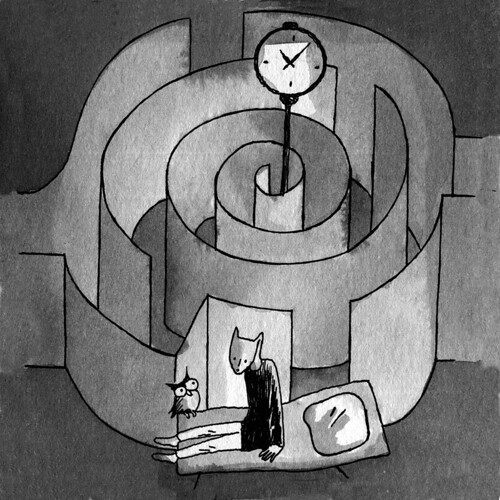Image: 'The Labyrinth of memory'
http://www.flickr.com/photos/36263437@N08/5285629858
Found on flickrcc.net
Beyond treating individual letters as physical objects, the human brain may also perceive a text in its entirety as a kind of physical landscape. When we read, we construct a mental representation of the text in which meaning is anchored to structure. The exact nature of such representations remains unclear, but they are likely similar to the mental maps we create of terrain—such as mountains and trails—and of man-made physical spaces, such as apartments and offices. Both anecdotally and in published studies, people report that when trying to locate a particular piece of written information they often remember where in the text it appeared. We might recall that we passed the red farmhouse near the start of the trail before we started climbing uphill through the forest; in a similar way, we remember that we read about Mr. Darcy rebuffing Elizabeth Bennett on the bottom of the left-hand page in one of the earlier chapters.The article is much longer and points to other areas where e-reading is often less desirable than reading the printed page, but this area stuck me the most.
In most cases, paper books have more obvious topography than onscreen text. An open paperback presents a reader with two clearly defined domains—the left and right pages—and a total of eight corners with which to orient oneself. A reader can focus on a single page of a paper book without losing sight of the whole text: one can see where the book begins and ends and where one page is in relation to those borders. One can even feel the thickness of the pages read in one hand and pages to be read in the other. Turning the pages of a paper book is like leaving one footprint after another on the trail—there's a rhythm to it and a visible record of how far one has traveled. All these features not only make text in a paper book easily navigable, they also make it easier to form a coherent mental map of the text.
During Thanksgiving weekend of 2011, I read Moonwalking with Einstein by Joshua Foer. I often marvel at those people with fabulous memories and I wonder how they do it. How do you memorize so many numbers of Pi? How do you memorize cards during card tricks and gambling? One technique that Foer shares from the centuries of memory masters (he calls contemporary ones mental athletes) is that they visualize a home or a building they know really well and place their memories in locations in the house (or memory palace). Then, they can tour through the house and have this mental map, which gives context to the details they are memorizing. Sometimes instead of a home, mental athletes will image something else, a streetmap they know well, or the human body, "so long as there is some sense of order that links one locus to the next, and so long as they are intimately familiar" (97). One person could have many memory palaces, one for each thing being remembered.
This type of memorization technique must be somehow related to the "mental maps" above that Jabr writes about in Scientific American. Perhaps the physical space of a book naturally helps our brains remember the stories better. Thinking of a book as a structure, or memory palace, and knowing where events happen, and what details occur on what page, probably helps with remembering and context. I wonder if the memory masters Foer writes about prefer e-books or print books for learning.

No comments:
Post a Comment